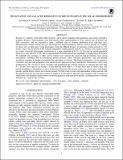The Rotation and Galactic Kinematics of Mid M Dwarfs in the Solar Neighborhood
Author(s)
Newton, Elisabeth R.; Irwin, Jonathan; Charbonneau, David; Dittmann, Jason A.; West, Andrew A.; Berta-Thompson, Zach; ... Show more Show less
DownloadNewton-2016-THE ROTATION and GAL.pdf (3.236Mb)
PUBLISHER_POLICY
Publisher Policy
Article is made available in accordance with the publisher's policy and may be subject to US copyright law. Please refer to the publisher's site for terms of use.
Terms of use
Metadata
Show full item recordAbstract
Rotation is a directly observable stellar property, and it drives magnetic field generation and activity through a magnetic dynamo. Main-sequence stars with masses below approximately 0.35 ⊙ (mid-to-late M dwarfs) are fully convective, and are expected to have a different type of dynamo mechanism than solar-type stars. Measurements of their rotation rates provide insight into these mechanisms, but few rotation periods are available for these stars at field ages. Using photometry from the MEarth Project, we measure rotation periods for 387 nearby, mid-to-late M dwarfs in the northern hemisphere, finding periods from 0.1 to 140 days. The typical rotator has stable, sinusoidal photometric modulations at a semi-amplitude of 0.5%–1%. We find no period–amplitude relation for stars below 0.25 ⊙ and an anticorrelation between period and amplitude for higher-mass M dwarfs. We highlight the existence of older, slowly rotating stars without Hα emission that nevertheless have strong photometric variability. We use parallaxes, proper motions, radial velocities, photometry, and near-infrared metallicity estimates to further characterize the population of rotators. The Galactic kinematics of our sample is consistent with the local population of G and K dwarfs, and rotators have metallicities characteristic of the solar neighborhood. We use the W space velocities and established age–velocity relations to estimate that stars with P < 10 days have ages of on average <2 Gyr, and that those with P > 70 days have ages of about 5 Gyr. The period distribution is dependent on mass: as the mass decreases, the slowest rotators at a given mass have longer periods, and the fastest rotators have shorter periods. We find a lack of stars with intermediate rotation periods, and the gap between the fast and slow rotators is larger for lower masses. Our data are consistent with a scenario in which these stars maintain rapid rotation for several gigayears, then spin down quickly, reaching periods of around 100 days by a typical age of 5 Gyr.
Date issued
2016-04Department
Massachusetts Institute of Technology. Department of Physics; MIT Kavli Institute for Astrophysics and Space ResearchJournal
The Astrophysical Journal
Publisher
IOP Publishing
Citation
Newton, Elisabeth R. et al. “The Rotation and Galactic Kinematics of Mid M Dwarfs in the Solar Neighborhood.” The Astrophysical Journal 821.2 (2016): 93. © 2016 The American Astronomical Society
Version: Final published version
ISSN
1538-4357